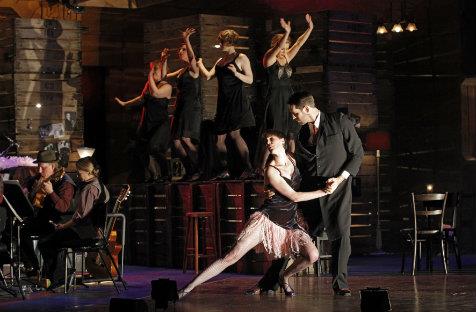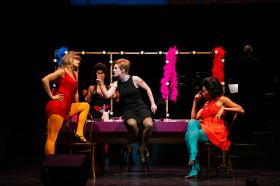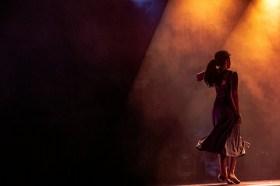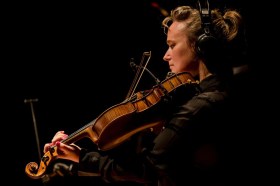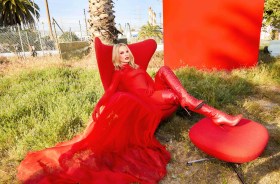Running true to form, Victorian Opera has once again taken an artistic risk that has paid off handsomely. Nigel Levings’ transformation of the Elisabeth Murdoch Hall into a seedy Buenos Aires bar is inspired. A series of pillars made from rough planks, like giant-sized crates, not only blends with the interior of the hall remarkably well, but also serves to emphasize the more brutal aspects of the text. Furnishings of makeshift tat add to the dimly lit, decadent atmosphere. The costumes range from functional to down-at-heel to beautiful, Maria’s absinthe green fairy costume being the most notable.
In his only opera, Astor Piazzolla’s haunting music is the element that takes us most compellingly to the back streets of Buenos Aires, the birthplace of tango. Walking along a more salubrious street of Melbourne, discussing the libretto and its intricate meanings with a friend, we were interrupted by a young Argentinian woman who had just shared our experience. For her, those first strains of Piazzolla’s music were so deeply evocative of everything that tango stands for – a whole cultural history of Buenos Aires, that she was immediately moved to tears. Victorian Opera Tango Nuevo Ensemble’s expert playing would have been an important contributor to this response. Although an actual bandoneon was not used in this production, James Crabb’s classical accordion was mesmerizing. Under his direction and with Elizabeth Jones’ supple, sweet-toned violin, the ten players gave a first-rate performance of alluring tangos.
The more challenging aspect that had been under discussion was the libretto. Declaimed and sung in Spanish, a translation of a dense and complex libretto by the Uruguayan poet and writer Horacio Ferrer was provided in surtitles. Despite being a distraction from the action on stage, this was the only possible compromise. Non-Spanish speakers undoubtedly missed out on some layers of meaning, but much more would have been lost in translation into English. The sound of Spanish is an essential ingredient of this work; without it the whole flavor and texture of Buenos Aires would have been lost.
As Narrator, Alirio Zavarace was a commanding presence. With a strong, expressive voice and eloquent gestures, his delivery was invested with the power and intensity required for this crucial role: El Duende (The Goblin), the spirit of evocation, who tells Maria’s story. As Andrea Katz says in her excellent program notes, ‘…he is part Evangelist, part Mephisto, narrating her life like a Passion punctuated by the demonic rituals of Macumba and Black Mass’. The resonances of the sacred and the profane are many and varied. The name Maria itself conjures up Mary, the mother of Jesus, as well as Mary Magdalene and the original name of the city itself. She is a composite and the embodiment of Tango. Further mythic elements can be seen in the allusion to Maria growing up in seven days.
To play Maria needs a special array of talents. Tall and slender, Cherie Boogaart appeared to be equally at home as an actress, a tango dancer and a singer. From raw and earthy to operatic and soaring, Boogaart’s vocal armoury is prodigious. As its chief weapon, a tremulous emotional quality was used to portray a situation of desperation and pathos.
Emotional involvement also marked the vocal performance of Nicholas Dinopoulos as the Cantor. Whether in the guise of troubadour, pimp or psychoanalyst, he wove in and out of the life of Maria, deliberating on what it might signify. It is he who had the last softly (and beautifully) sung words.
For tango fans, Leigh Warren’s collaboration has resulted in a series of dances interspersed throughout the 16 scenes from Maria’s life. His four dancers gave polished performances of some stylish and inventive choreography. The dancing skills as well as the vocal skills of the eight members of Victorian Opera Chorus were also called upon, revealing some unexpected talent.
There is so much to absorb in this opera cum piece of music theatre that one viewing hardly does it justice. The extraordinarily involving music alone is worthy of undivided attention, especially as performed by this band of musicians. Music, libretto, choreography, staging and performances have combined to provide what is ultimately a fascinating vision of the mysterious and emotionally charged world of Maria de Buenos Aires. It is well worth a visit.
Rating: 4 ½ stars out of 5
Maria de Buenos Aires
Astor Piazzolla, composer
Horacio Ferrer, librettist
Presented by Victorian Opera in association with Leigh Warren Dancers and the State Opera of South Australia
James Crabb, conductor
Leigh Warren, director
Andrea Katz, music preparation & direction
Nigel Levings, set & lighting designer
Kathryn Sproul, costume designer
CAST
Maria: Cherie Boogaart
Narrator: Alirio Zavarce
Cantor: Nicholas Dinopoulos
Tango Dancer: Andrew Gill
Magician: James James (James Hester)
Contortionist: Jacinta Rohan
Dancer 1: Rebecca Jones
Dancer 2: Elizabeth Vilmanis
Dancer 3: Glen McCurley
Dancer 4: Michael Pappalardo
Leigh Warren & Dancers
Victorian Opera Tango Nuevo Ensemble
Victorian Opera Chorus
Elisabeth Murdoch Hall, Melbourne Recital Centre
21 – 24 August
(Pictured: Cherie Boogaart as Maria and Andrew Gill as Tango Dancer in Victorian Opera’s Maria de Buenos Aires. Photo: Jeff Busby)

